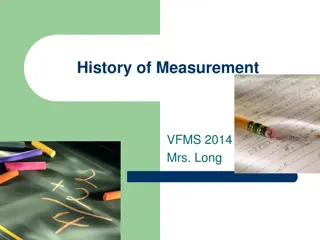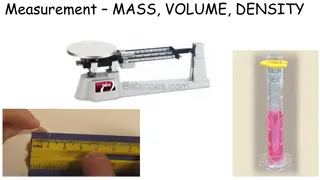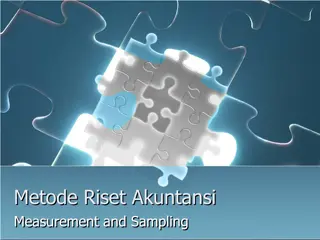Understanding Volume Measurement in Metric Units
Explore the concept of volume measurement in metric units through lessons on English vs. metric units, measuring liquid volume with graduated cylinders, and calculating solid volume using formulas. Understand the relationship between liters, milliliters, and other units, and learn practical techniques for measuring volume accurately in various contexts.
Download Presentation

Please find below an Image/Link to download the presentation.
The content on the website is provided AS IS for your information and personal use only. It may not be sold, licensed, or shared on other websites without obtaining consent from the author. Download presentation by click this link. If you encounter any issues during the download, it is possible that the publisher has removed the file from their server.
E N D
Presentation Transcript
Lesson 3: Volume T. Trimpe 2008 http://sciencespot.net/
English vs. Metric Units 1 quart = 0.946 liters Which is larger? A. 1 liter or 1 gallon B. 1 liter or 1 quart C. 1 milliliter or 1 fluid ounce 1 gallon = 3.79 liters 1 fl oz = 29.573 ml 1 12-oz can of soda would equal approximately 355 ml. It would take approximately 3 1-liter bottles to equal a gallon.
kL mL cL L Metric Units Volume is the amount of space an object takes up. The base unit of volume in the metric system in the liter and is represented by L or l. Standard: 1 liter is equal to one cubic decimeter Metric Units 1 liter (L) = 1000 milliliters (mL) 1 milliliter (mL) = 1 cm3 (or cc) = 1 gram* Which is larger? Volume video clip A. 1 liter or 1500 milliliters B. 200 milliliters or 1.2 liters C. 12 cm3 or 1.2 milliliters* * When referring to water Liter Image: http://www.dmturner.org/Teacher/Pictures/liter.gif
Measuring Volume We will be using graduated cylinders to find the volume of liquids and other objects. Read the measurement based on the bottom of the meniscus or curve. When using a real cylinder, make sure you are eye-level with the level of the water. What is the volume of water in the cylinder? _____mL What causes the meniscus? A concave meniscus occurs when the molecules of the liquid attract those of the container. The glass attracts the water on the sides. Top Image: http://www.tea.state.tx.us/student.assessment/resources/online/2006/grade8/science/images/20graphicaa.gif Bottom Image: http://morrisonlabs.com/meniscus.htm
Measuring Liquid Volume What is the volume of water in each cylinder? Images created at http://www.standards.dfes.gov.uk/primaryframework/downloads/SWF/measuring_cylinder.swf A B C Pay attention to the scales for each cylinder.
Measuring Solid Volume We can measure the volume of regular object using the formula length x width x height. 9 cm _____ X _____ X _____ = _____ 8 cm 10 cm We can measure the volume of an irregularly-shaped object by filling the graduated cylinder to 25 mL of water. Then carefully submerged the irregularly-shaped object. Read the new amount on the graduated cylinder. Then subtract the lower number (25) from the higher volume. The difference is the volume of the object. http://resources.edb.gov.hk/~s1sci/R_S1Science/sp/e n/syllabus/unit14/new/testingmain1.htm Amount of H2O with object = ______ About of H2O without object = ______ Difference = Volume = ______























